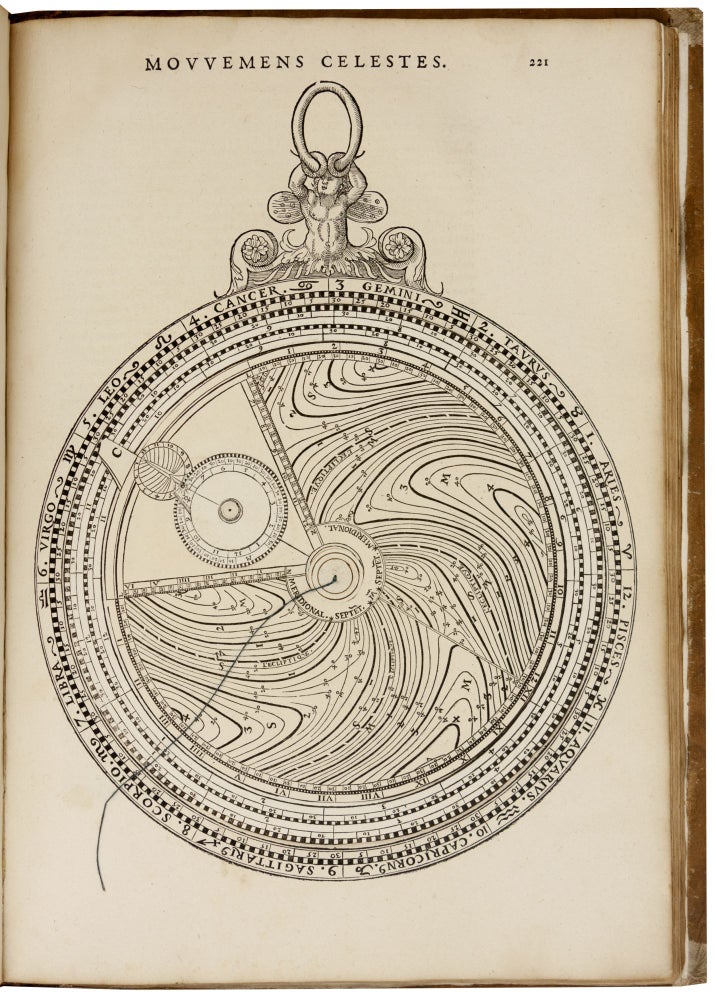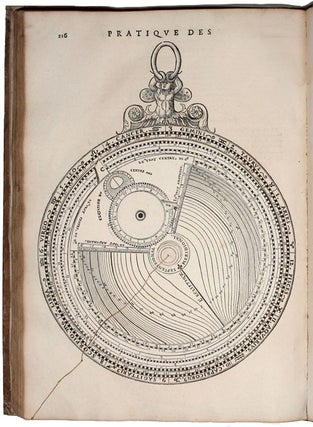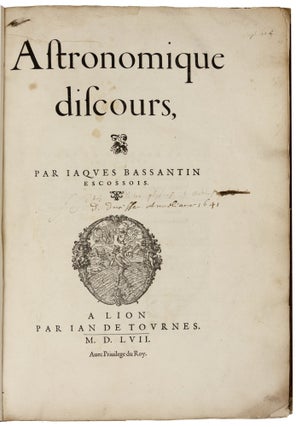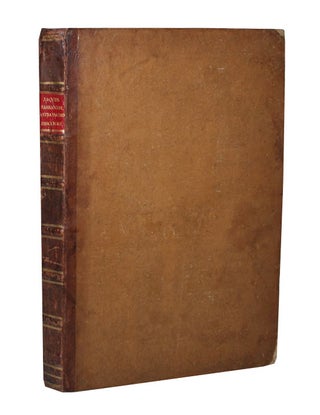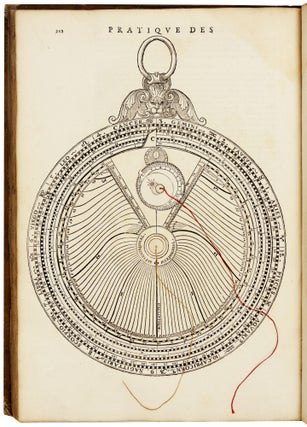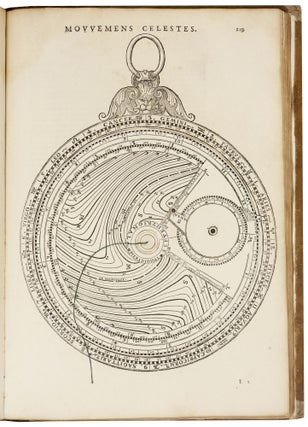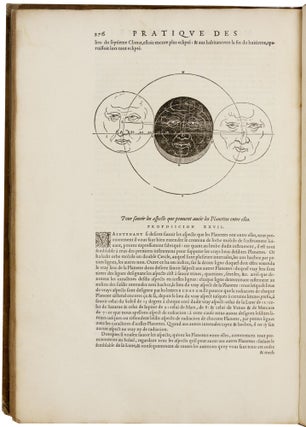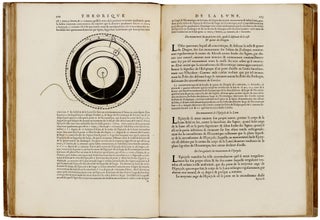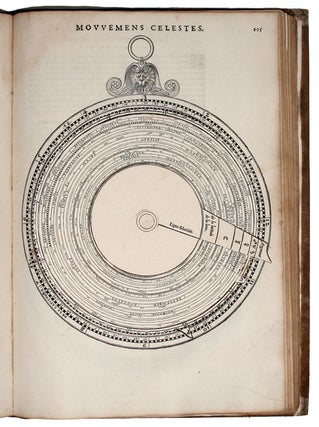Astronomique discours, par Jaques Bassantin Escossois.
Large folio [44 x 31cm], 285 pp., (1) p., (1) f., with 175 woodcuts in text (including numerous diagrams) 14 of which are volvelles (13 full-page, 1 half-page) composed of 36 total parts. Quarter bound in late eighteenth- or early nineteenth-century brown calf and brown paste boards. Spine in seven compartments, gold-tooled red morocco title piece laid to spine. Some light rubbing and edge wear to spine and boards. Ownership inscription on title page, negligible water-staining in upper inner margin of quires a to e and h to p, minor corner loss at p. 29, minor marginal loss at p. 170, repaired marginal tear at p., 230, very slight occasional staining; many diagram indicator strings preserved.
Very rare complete first edition of the Scotsman James Bassantin’s (c. 1500-68) copiously illustrated, large-format compendium on calculating planetary positions. The Astronomique discours, which took as its forebear Peter Apian’s famous (1495-1552) Astronomicum Caesareum (1540), includes among its 175 woodcuts a total of 14 volvelles (13 of which are full page), here complete with all 36 moving parts. The discs of these paper instruments perform many functions conventionally associated with the astrolabe, such as simulating the movement of planets, reckoning time, and assisting with the practical matters of surveying and astrology. “A Scottish astronomer of considerable reputation,” Bassantin cut no corners in producing the Astronomique discours: “The size of this volume and the extent of its illustration and ornamentation make this an unusually fine example of the attention given to the printing of scientific works at this period” (Mortimer, p. 64).
The text of the Astronomique discours is arranged in several ‘treatises’ of increasing complexity, beginning with information about understanding sine tables and trigonometry, moving to the application of these principles to the terrestrial and celestial spheres and to the interaction of planets, and closing with a lengthy section concerning practical problems of the heavens (the majority of the work’s volvelles are contained here). While Bassantin gives the reader much information in textual and tabular formats, his illustrations provide the bulk of the didactic force and do so without sacrificing beauty (e.g., its armillary sphere supported on the back of Atlas, its handsome volvelle of the constellations of the northern hemisphere, the glowering moon-faces in discussions of eclipse, the fine metalwork form of its paper instruments).
James Bassantin studied at the University of Glasgow and seems to have taken pride in his Scottish heritage even as his work took him to the continent (e.g., he prominently identifies himself as “Escossois” on this work’s title page and lists 8 Scottish towns in his tables of longitude and latitude). Bassantin eventually settled in France as a teacher of mathematics, first at Lyon and then in Paris. His revised edition of Jacques Foucard’s Paraphrase de l’astrolabe (1555) shows him to have been familiar with the most recent advances in German and Italian mathematics and astronomy. Bassantin returned to Scotland in 1562 and on route discussed with Sir Robert Melville the current political tensions in the Isles, predicting that there would be “at length captivity and utter wreck” for Mary, Queen of Scots, at the hands of Elizabeth, and that the kingdom of England would eventually fall to the crown of Scotland (comments preserved by Sir James Melville, Robert’s brother, in Memoirs of his own life, p. 203; see also DNB). Bassantin’s astrological acumen seems to have appealed to the superstitious James VI (James I of England and Ireland) who kept in his library a copy of the Astronomique discours inherited from the collection of Mary (“de la royne”: see Warner, p. lix).
The present copy carries the ownership inscription of Jean Perrin (1613-95), doctor to the dukes of Lorraine, who served Marguerite de Lorraine, the second wife of Gaston d’Orléans (1608-60): “J. Perrin, doctor physicus et medicus … D. Ducissae Aureliacae, 1641”.
The correct collation of the volvelle parts to this 1557 first edition has long been a matter of debate among bibliographers, with Mortimer calling for 36, although most otherwise well-preserved, extant copies retain between 33 and 35 parts. The present volume is one of only a very few (e.g., the Horblit-Vershow copy) known to contain all 36 parts.
OCLC locates U.S. copies at NYPL, Cal Tech, Library of Congress, Adler Planetarium, and Harvard (imperfect).
* Brunet I, 692; Cartier II, 357; Mortimer, French, no. 47; Gültlingen, IX, 368; Graesse, I, 308; Adams B-369; Poggendorff, vol. 1, col. 113; Honeyman 244; Horblit 89; Warner, The Sky Explored, p. 17; DNB, vol 3., pp. 372-3; George F. Warner, The Library of James VI, p. lix.
Price: $145,000.00

